War is a driving force behind innovation and invention, and every change or advancement in weapons technology impacts the tactics and the style of warfare utilized at the time. Due to new artillery and small arms weapons, the phalanx style of fighting (troops staying and moving together in formation) familiar in the Revolutionary War and the early part of the Civil War gradually gave way to the trench style warfare common in WWI. The changes in military tactics, however, were not confined to land: new steam powered ships and submarines challenged the age old conventions of masted naval warfare (sailing ships). During the Civil War, North Carolina from Fort Fisher and Bentonville all the way to Bennett Place saw and experienced the impact of changing weapons technology.
Infantry Weapons (Small Arms)
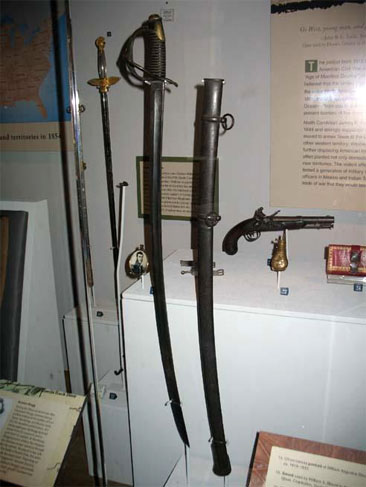
The Civil War was initially romanticized by many young men. A large part of the soldier ideal of the time included an edged weapon of some sort, usually a saber. The initial sabers were Dragoon style meaning they were heavy cavalry sabers which could be awkwardly weighted and extremely long, with some possessing blades up to a yard in length. Sabers themselves were used as thrusting weapons with the only sharp section being the tapered tip. As a testament to the chivalrous beginnings of the war, when Union cavalrymen began sharpening the edges of their sabers, Confederates who had learned of it apparently protested, claiming that using sharpened sabers did not fit within the rules of modern warfare.
While cavalrymen (men on horseback) carried sabers, other ranks were known to have utilized different edged weapons. Artillerymen (operating large weapons such as canon) for example carried a short sword used mainly for swiping at charging cavalrymen. The sword’s shape itself resembled that of an ancient Roman gladius. Another popular and overlooked edged weapon of the era was the knife. Many knives carried by soldiers were mass produced by armories such as the Confederate States Armory in Kenansville, North Carolina. However, even more knives were made in small scale blacksmith shops up and down the east coast. Interestingly, at the beginning of the war when more sophisticated weapons were not readily available, soldiers were sometimes equipped with medieval style lances and pikes which were quickly replaced as supplies grew.
Bladed weapons are useful, but they were no match for the state of the art small arms (revolvers and rifles) being developed at the time. Old flintlock style rifles and pistols ensured that a soldier could only fire once every minute or so. The creation of percussion cap systems ushered in a new wave of rifles and revolvers with increased rates of fire. Accuracy was soon increased with the introduction of the French Minié ball bullet, with its cylindrical body, rounded tip, and hollow bottom, replacing the extremely inaccurate ball style bullet. At the onset of the Civil War, both sides were forced to purchase large numbers of ineffective weapons from Europe so they could at least put a gun in a majority of their soldiers' hands. As the war progressed, so did weapons manufacturing and technology within the States.
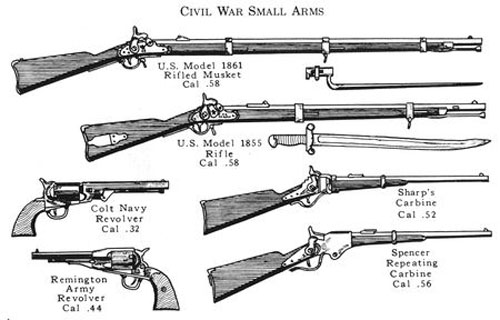
Rifles were the most common and most accurate of the small arms at the time. Five types of rifles were developed for the war: rifles, short rifles, repeating rifles, rifle muskets, and cavalry carbines. Each type was built for a specific purpose and was meant to be used by a specific person. Short rifles and cavalry carbines are very close to the same gun and were used by close-quarters fighters where a long barrel was inefficient. Cavalry carbines were simply short rifles designed to be used on horseback. Even with advancements in firing mechanisms, the average soldier was still confined to shooting two to three rounds per minute in often strict formation. With the invention of the repeating rifle, the traditional firing routine was no longer effective. Rifles like the Spencer rifle could contain a large number of self-contained rounds, increasing the firing rate of the rifle and protecting the rounds from the elements. By the end of the war, rifle and optics technology had progressed so far that it was possible to possess a rifle capable of accurate fire up to 1000 yards.
Handguns, due to their portability and relative accuracy, were fast becoming the additional weapon of choice for many Civil War soldiers, replacing the swords of past battles. Revolvers had their drawbacks, the process of loading was tedious and time consuming and the soldier could only rely on a few of the rounds to actually fire in succession. When they did fire, the handguns were only accurate to 50 yards. Large companies such as Colt Patent Firearms and Remington began mass producing both single and double action revolvers for the Union. The Confederacy, however, was forced to use inexperienced, unskilled labor, and close to zero raw materials for their revolver production efforts. Because of this, the build quality suffered in all areas.
As heavy fortifications and trench warfare began to take hold in the Civil war, hand grenades were developed to aid in the assault on those positions. Civil war era grenades were shaped like a dart, complete with long stabilization fins in the rear. A plunger style striker was positioned at the nose of the grenade. When thrown, the grenade would impact the ground on the striker; the weight of the grenade would push the striker into a percussion cap detonating the explosive charge. Interestingly, Confederate soldiers became adept at using cushioning devices such as blankets to catch the grenades without detonation to throw them back.
Field Artillery
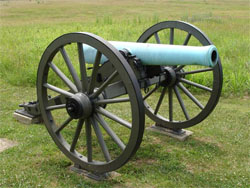
Already by the initial signs of confrontation between the North and the South there existed five separate categories of artillery: field, siege and fortification, seacoast, mountain and prairie, and volley/rapid fire (Gatling). Field artillery was designed to be easily moved about in a shifting, dynamic, battlefield. To do so they were made to be lightweight, mobile, and of relatively small caliber.
The most famous field gun of the early Civil War was the French-developed bronze smoothbore canon nicknamed “The Napoleon” after its designer Louis Napoleon. Siege and fortification style guns were large caliber, heavy guns that did not readily move due to their size and weight. The fortification guns in fact were meant to be so large that they were used as permanent fixtures in forts. Seacoast artillery were mainly fortification guns that were stationed in coastal forts, designed to protect large harbors and cities like Charleston or Wilmington. Mountain and prairie guns, the smallest of the basic artillery had to be able to be broken down and transported by carriage throughout the countryside.
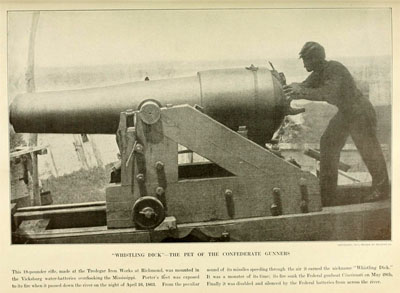
The civil war advanced many aspects of artillery technology from powder all the way to never before seen volley/rapid fire guns. Originally, powder was unreliable and unpredictable. Lemont DuPont of the DuPont company developed powder which could be tailor made for its intended purpose, providing for extra firepower and accuracy. North Carolina was in the forefront of rapid fire/volley artillery development. Born in Hertford County, North Carolina, Dr. Richard Jordan Gatling who was so distraught by the carnage of the war that he invented the World’s first successful rapid fire gun, the Gatling gun, in an effort to create a weapon so horrible that it would stop the Civil War in its tracks and prevent any future conflict from arising. Sadly, that dream of an end to violence did not come to pass.
More famous Confederate attempts at volley guns were seen mainly in North Carolina. The Vandenburgh Volley gun was originally invented by a Yankee, made in England, and then bought by Confederates. The gun itself was, at 400 pounds. and only thirty six inches long, extremely heavy for its size. Made of brass, it housed a cluster eighty five .50 caliber barrels only capable of firing at one time. The governor of North Carolina at the time allegedly purchased one gun and another two were able to slip through the coastal blockade and make it inland where one was captured near Salisbury, North Carolina, and the other was possibly added to the armament of Fort Fisher near Wilmington.
Naval
While large improvements were made on land, it became obvious soon after the Civil War’s inception that naval warfare would play a large role in victory. The Union needed to intercept ships bringing goods to the Confederacy from overseas. The Anaconda Plan, as it was known, was a naval strategy devised by Major General Winfield Scott where the U.S. Navy would blockade all southern ports from Virginia to Texas; it was reportedly “the largest blockade ever attempted by any country.” The Confederacy, as it did not possess any ships of consequence before the war, began building Ironclad ships, like the CSS North Carolina, to break through the U.S. Navy blockades. Competing ship designs and radical thinking characterized the second half of the Civil War’s naval technology. Outfitted with massive Parrot Rifles and Dahlgren guns, Ironclads like the famous USS Monitor were effective weapons against traditional ships. In a battle against another Ironclad however, they were often evenly matched and sometimes only sunk due to accidents or weather related incidents.
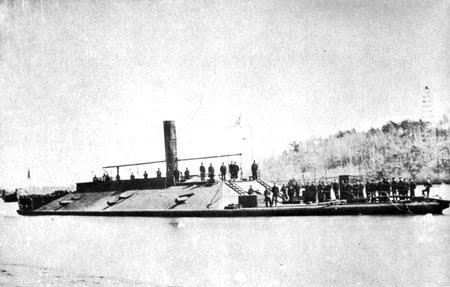
Impenetrable above the water line, they were still built on wooden hulls making them highly vulnerable below. To take advantage of this vulnerability, and break the blockade, Confederate engineers designed craft to go below the waves in the form of submarines, like the C. L. Hunley, torpedo boats, and mine-like torpedoes. Each craft was often powered by either man or steam and was outfitted with a spar attached to the bow which held an explosive charge which could be rammed into the wooden undersides of blockading ships and ironclads.
Unfortunately, one of the easiest ways to see the impact of changing military technologies is through the wake of death and destruction it leaves behind. In total, roughly 620,000 were killed in the war with over 30,000 in North Carolina alone. To keep the death toll at bay, such large leaps forward in weapons technology needed to be countered with leaps forward in personal protection, defense technology, and battlefield medicine. In the Civil War unfortunately, military technology was only countered with more military technology leading to an ever increasing spiral of injuries and casualties.